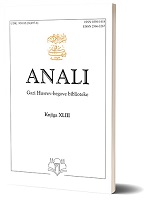ALI FAGINOVIĆ I NJEGOVE DVIJE DERVIŠKE MEDŽMUE
Ali Faginović and his two dervish mağmūʻas
Author(s): Aida Smailbegović, Emrah SeljaciSubject(s): Language and Literature Studies, Visual Arts, History of Islam, Contemporary Islamic Thought, Theory of Literature
Published by: Gazi Husrev-begova biblioteka
Keywords: Ali Faginović; mağmūʻa; islamic calligraphy; sufi literature;
Summary/Abstract: Ali Faginović was an appreciated Bosnian scholar, primarly active at the end of the XIX and the beginning of the XX century. Biographical data that we have about his early life is very scarce. He comes from a very rich and respectable family of Faginović that comes from Hrid. From the defiled analysis of his rich opus of calligraphic panels (lawḥas), manuscripts, and archival materials, we can clearly say that he was truly sūfī and an excellent calligrapher. During his life, he obtained several functions, and his public engagement can be followed from the beginning of 1887, especially from the date when the first diploma (iğāzat-nāma) was issued, originated from his school. Following archival materials, we see that Faginović, starting from 1889, was engaged in various jobs: from teacher to mutawallī, but he remained faithful to his primary vocation. Considering that manuscripts of dervish mağmūʻas are the best indicator for literary pretension and Sufi orientation, Faginović’s mağmūʻa from the manuscript collection of Gazi Husrev-beg library, except the fact that he knew oriental-islamic literature, reveals us that he wrote verses deeply woven with Islamic esotericism and gnosis. It was this detailed mağmūʻa that served as a basis on which we determined Faginović’s authorship of another manuscript that is part of the legacy of the Faginović family, stored in Bosniak Institute in Sarajevo. Comparing the content of these two mağmūʻas, and the one that is stored in The National and University Library of Bosnia and Herzegovina, which was written by Faginović’s son Salim Nijazi, we have established with certainty that both came from Ali Faginović’s pen. After comparing the analyses, we established their common and individual characteristics. Since both manuscripts are illuminated, in addition to the catalog description, we also paid attention to their visual analysis. The representation of the tekke ilāhī, as well as the shaykh tāğ, points us to Faginović’s extreme devotion to dervish order of Qādiriyya. His affection is particularly noticeable at Ahl al-Bayt, and the founder of dervish order of Qādiriyya ʻAbd al-Qādir al-Gaylānī. In his mağmūʻas Sufi works of Bosnian, Arab, Persian, and Ottoman authors are immortalized. Through all the presented data, which are based on primary archival sources, the personality of Ali Faginović – a famous Bosnian calligrapher and scholar, is additionally illustrated in this work.
Journal: Anali Gazi Husrev-begove biblioteke
- Issue Year: 2022
- Issue No: 43
- Page Range: 63-86
- Page Count: 24
- Language: Bosnian

